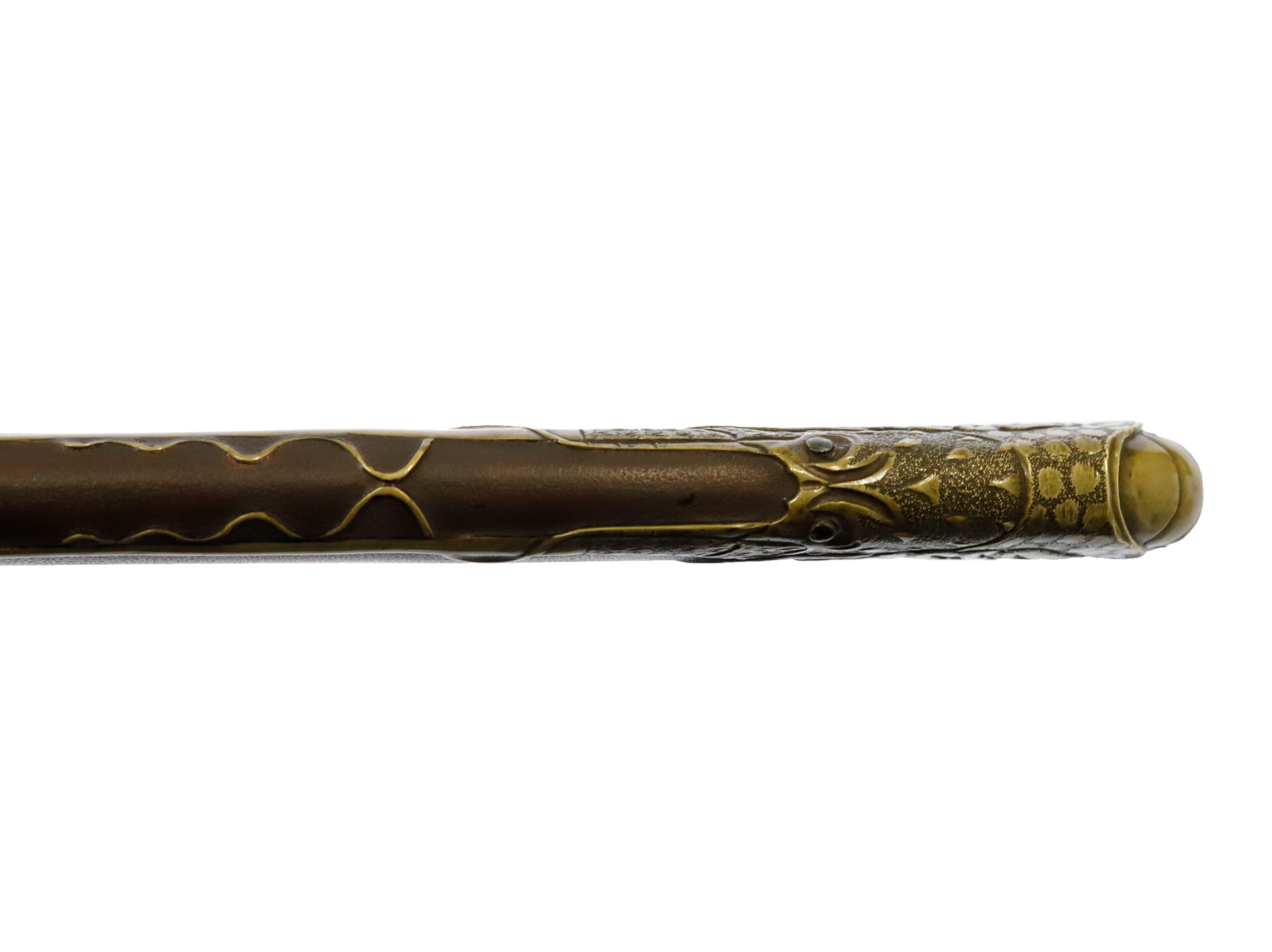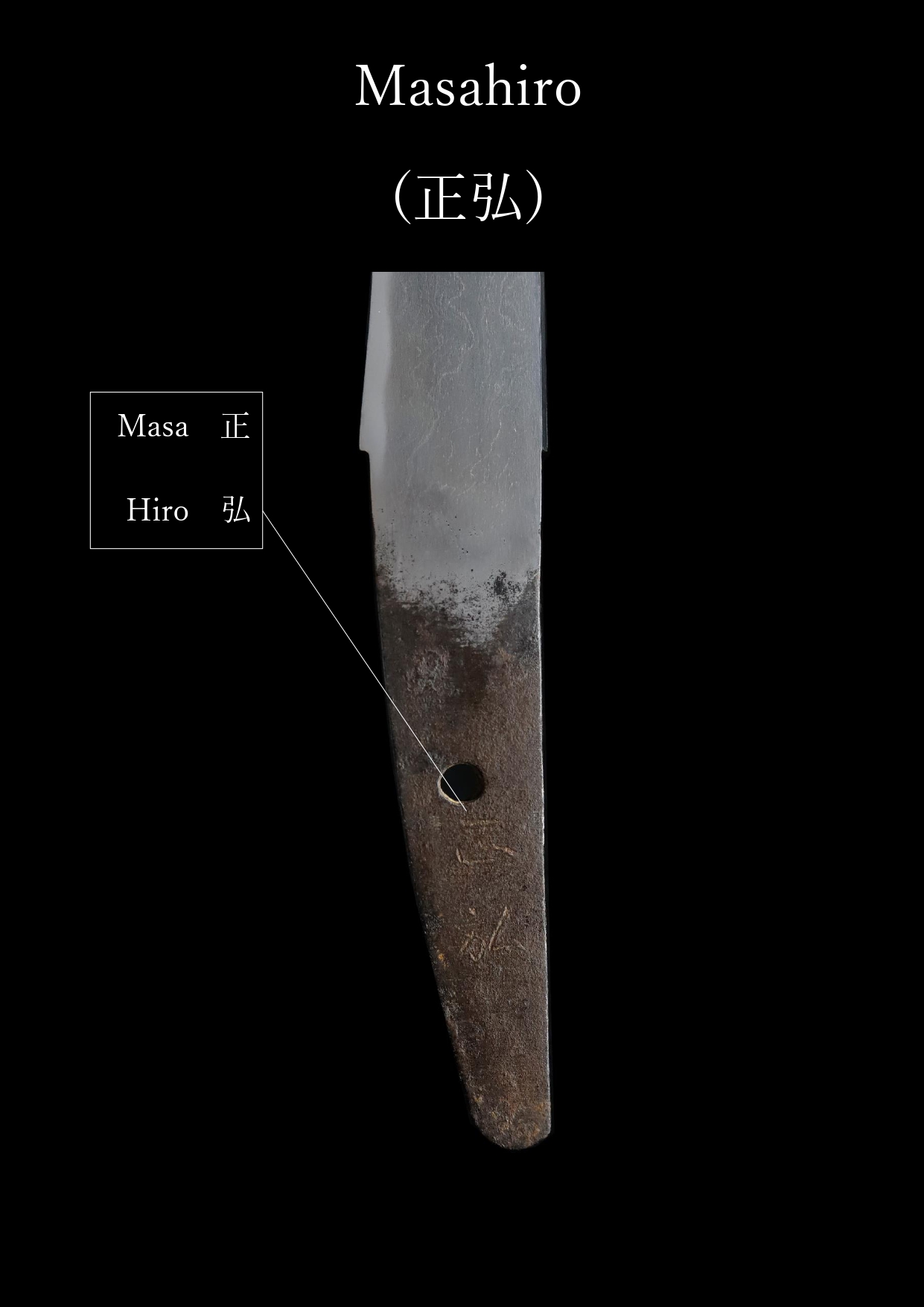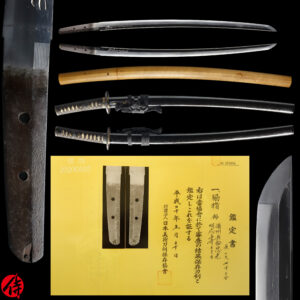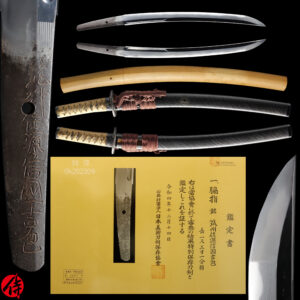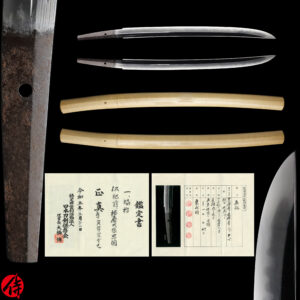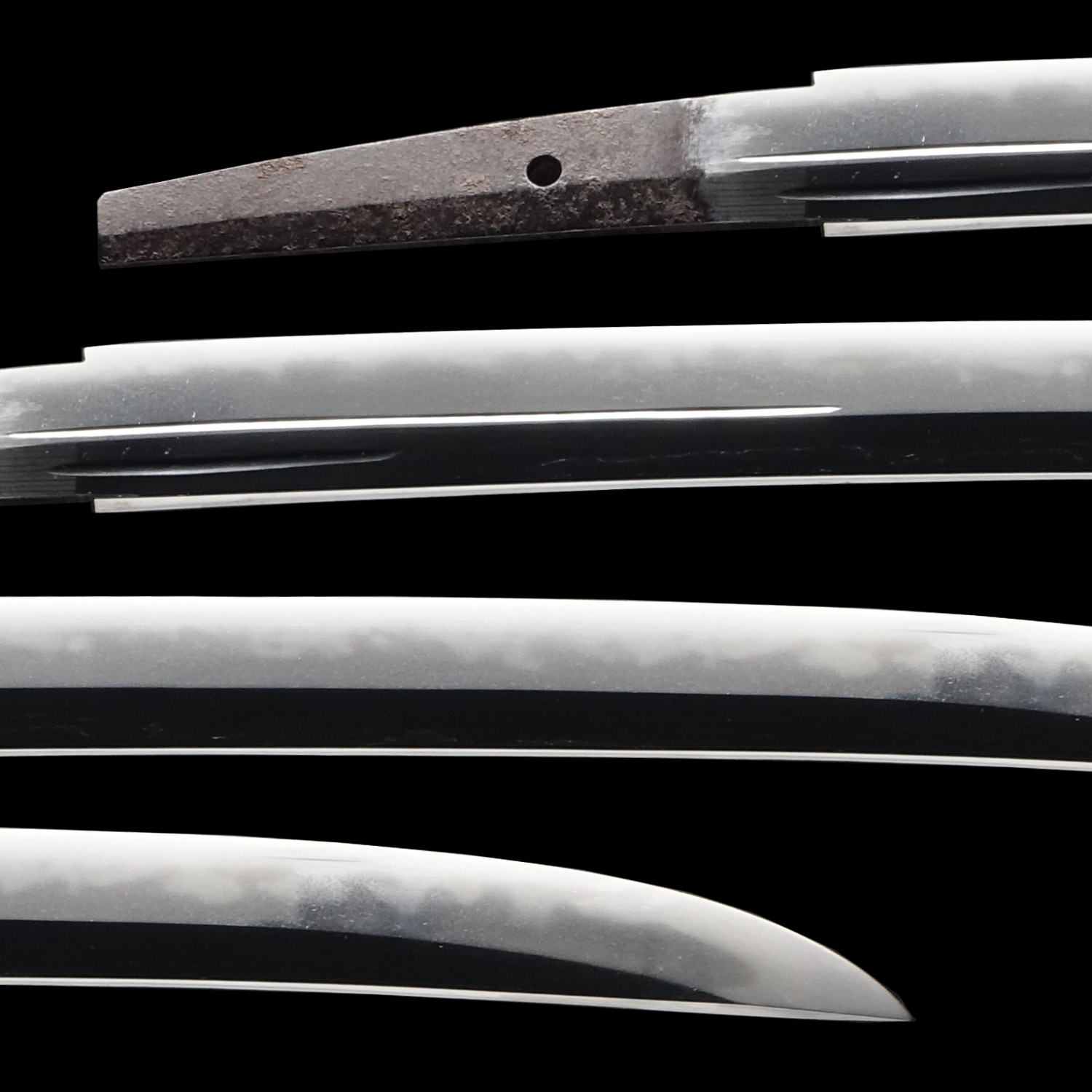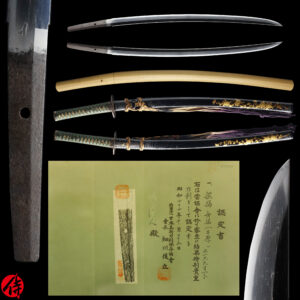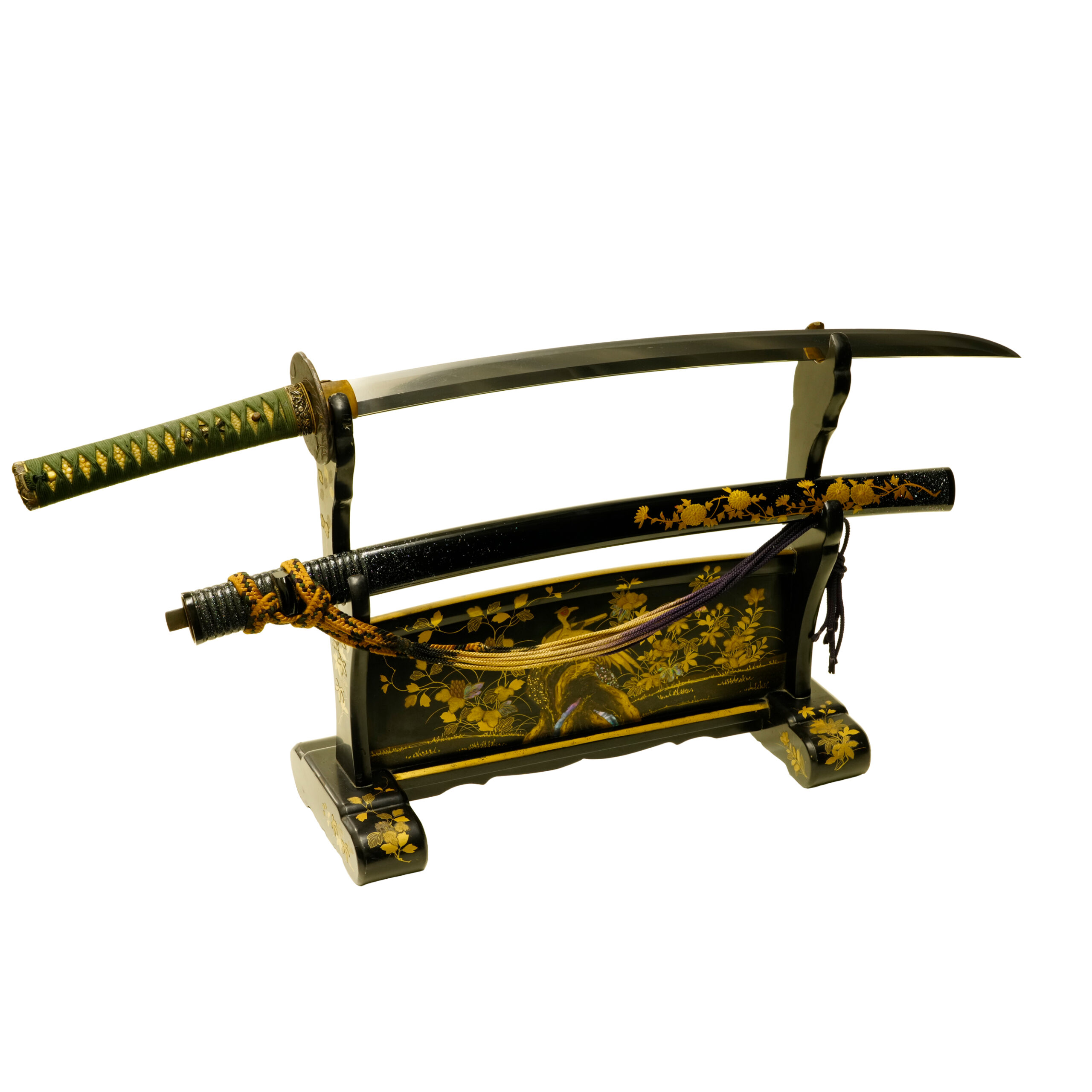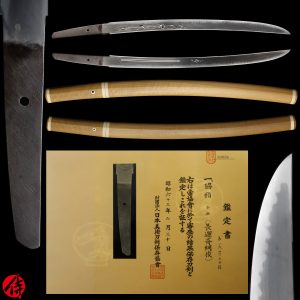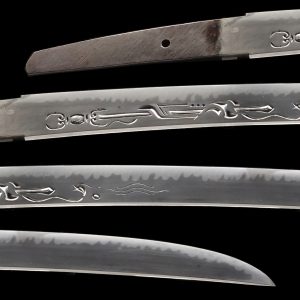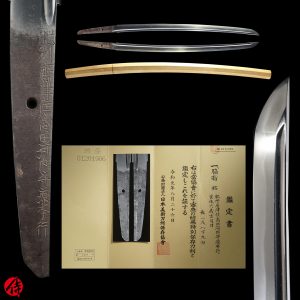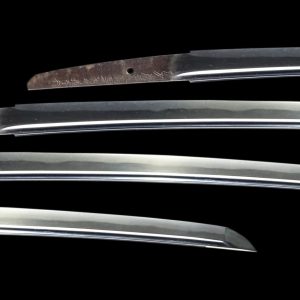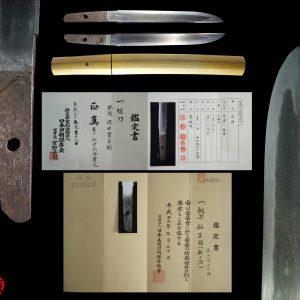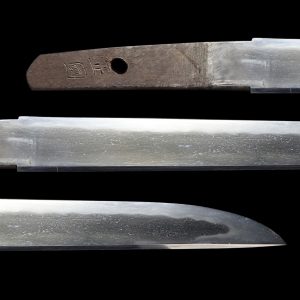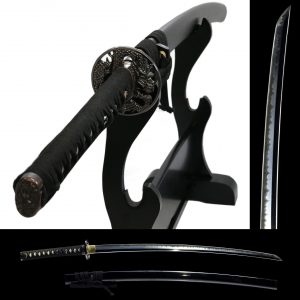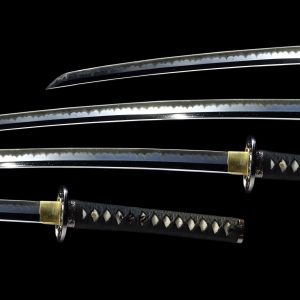Antique Japanese Sword Wakizashi Signed by Masahiro with NTHK Kanteisho Certificate
【Description】
Summary
This blade was signed by Masahiro (正弘). And according to NTHK that authenticated this blade, it was made during the Eisho era (Late Muromachi period : 1504-1521). There were a few swordsmiths who used Masahiro as their maker’s names during this time and NTHK thinks it was made by Soshu Masahiro (相州正弘). This swordsmith is not the same as Masahiro (正広) while the pronunciation is the same. Soshu is the name of the province located in today’s Kanagawa prefecture.
When this blade was forged, Japan was in the warring state called Sengoku Jidai where there were so many rivalry and wars between regional feudal lords. It is possible this blade was owned by a Samurai who participated in one of the warfare back then. We believe it would be nice to have a piece that was forged in the warring state period.
This blade is categorized as a Koto blade. The swords made between the Late Heian Period towards the end of the Warring States (930-1595 A.D.) are called KOTO (古刀: Old-Sword) in Japanese. Those swords were likely to be used in real lives of Samurai, so their designs had to fit the way they used the sword. The blacksmithing technique wasn’t fully developed yet in this era, so the KO-TO blades contain gold, silver, and other metals, making the surface pattern of Koto intricate and beautiful.

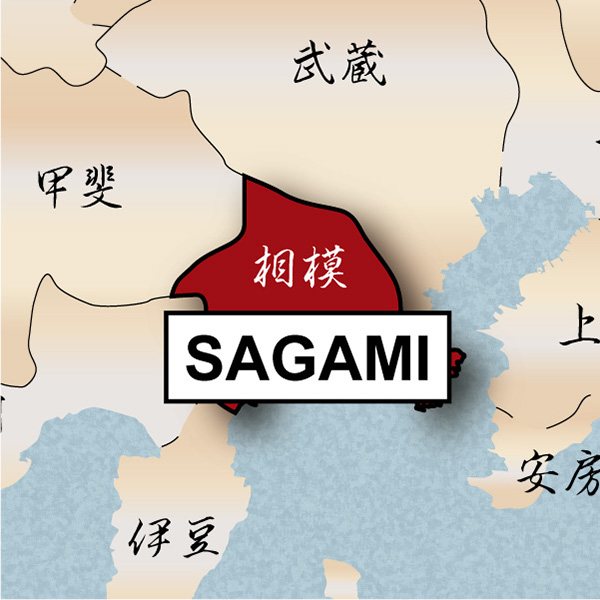
Sunnobi Tanto (寸延び短刀)
In Japanese sword terminology, this blade is categorized as a Wakizashi because its cutting edge length is more than 30 cm long. However, it is much shorter than the average Wakizashi sword. And it is very close to the Tanto sword. This Tanto is called Sunnobi Tanto, a Wakizashi sword whose cutting edge is very close to the category of Tanto (Cutting edge less than 30 cm). And it must have been used as a Tanto back in the day.
What is Tanto?
It was initially used as a supplemental weapon for Samurai on horseback, who used a pole weapon or long sword in the Kamaura-Muromachi period. Samurai aimed at an unprotected area of his enemy’s armor with Tanto while having to fight with close distance.
TANTO was named accordingly, depending on how you carry it, such as HUTOKORO-GATANA (懐刀; Stomach-Sword) or KOSHI-GATANA(腰刀; Waist-Sword) or elsewise. TANTO was also a gift for a bride from her family in a traditional Japanese wedding, as it is believed that TANTO would be divine protection from evil power.
Soshu Den
Swordsmiths residing in Soshu province used a particular sword-forging tradition called Soshu Den. Shoshu Den was born in the middle of the Kamakura period. Back then, the Yamato and Yamashiro traditions were highly developed, and there were a few renowned swordsmiths from those regions. However, the sword-forging practice was in its infancy in the Kanto area, where the Soshu region was located.
At the beginning of the Kamakura government, which was established in 1185, the first Shogun, Minamoto Yoritomo, prioritized making a lot of rules to have its political stability. And he couldn’t afford to hire swordsmiths within the same region or train them. Therefore, the Kamakura government originally ordered weapons to the swordsmiths in the other areas, such as Yamato and Yamashiro.
But, since the government was established, the demand for weapons increased exponentially in the government, and they had to figure out how to meet those demands from Samurai who served Kamakura shogunate. Then, the 5th head of the Shogun, Hojo Tokiyori, invited two renowned swordsmiths from other parts of Japan. They were Awataguchi Kunitsuna from Yamashiro province and Bizen Saburo Kunimune from Bizen province. And the 7th-gen Shogun Koreyasu Shino also invited Fukuoka Ichimonji Sukezane from Bizen province.
It is said that those three swordsmiths played an essential role in creating the Soshu Den and making the foundation of the Soshu Den. Also another famous figure in the Soshu den is Intou Kunimitsu, an adopted son of Awataguchi Knitsuna. And Kunimitsu passed his excellent craftsmanship to Yukimitsu, his apprentice. And Masamune, one of the most famous swordsmiths in Japanese history, was an apprentice of Yukimitsu. And Masamune was the one that brought Shoshuden to nationwide fame. The tradition Masamune completed became an example of other swordsmiths who learned Soshu Den. Also, Soshu Den influenced many renowned swordsmiths during the Koto- Shinto era. One of examples is Inoue Shinkai from Osaka and Suishinshi Masahide from Edo.
【 Blade】
Cutting Edge Length(Nagasa): 32.0 cm (12.6 inches)
Curvature(Sori): 0.3 cm ( 0.12 inches)

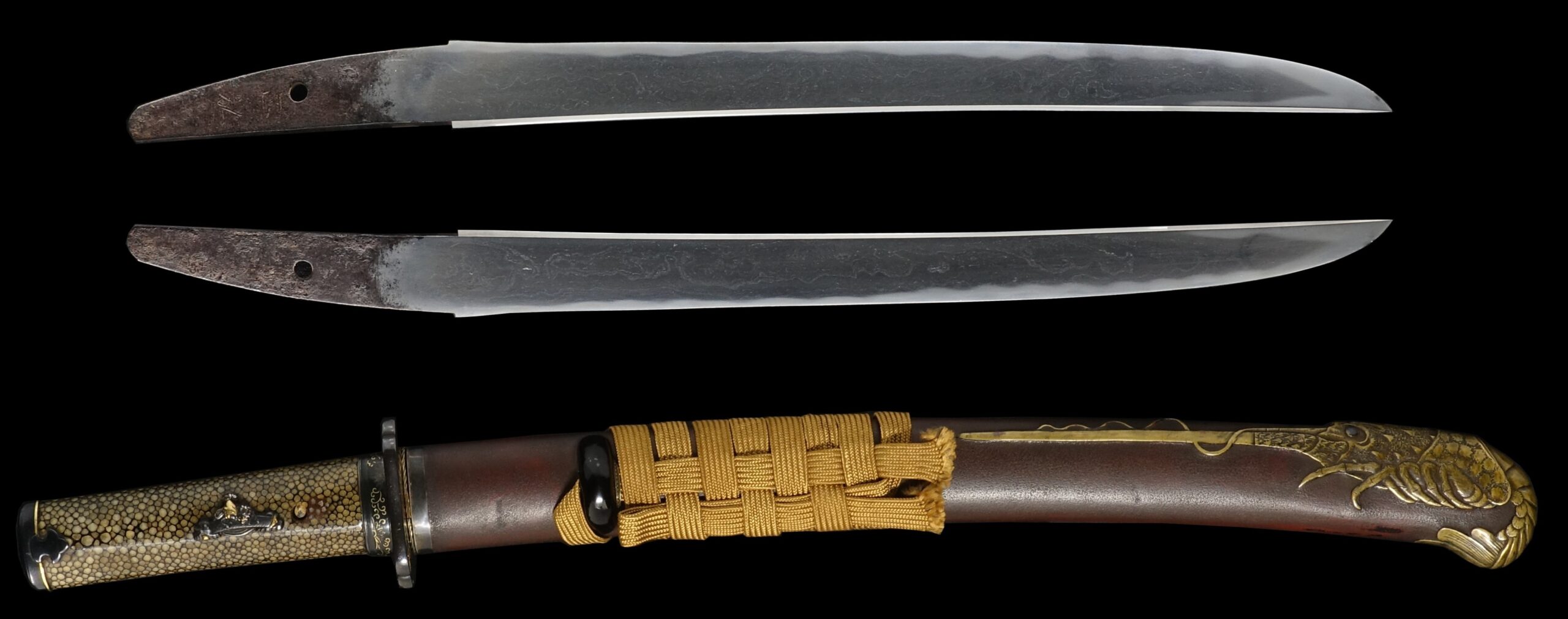
Hamon:
The crystalline structure which forms along the cutting edge of a blade as a result of the hardening process
Jimon(Jihada):
visible steel surface pattern created by folding and hammering during forging process
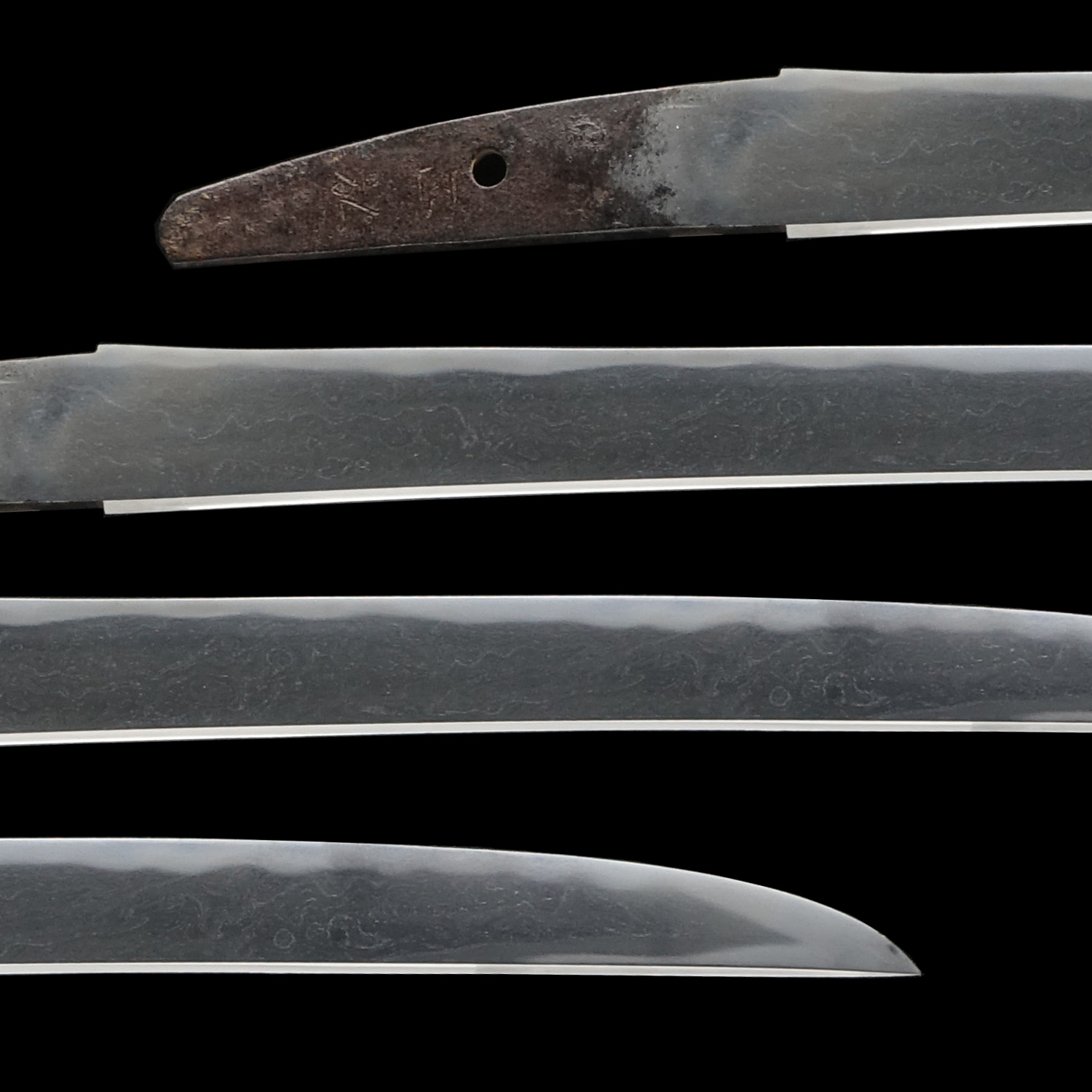
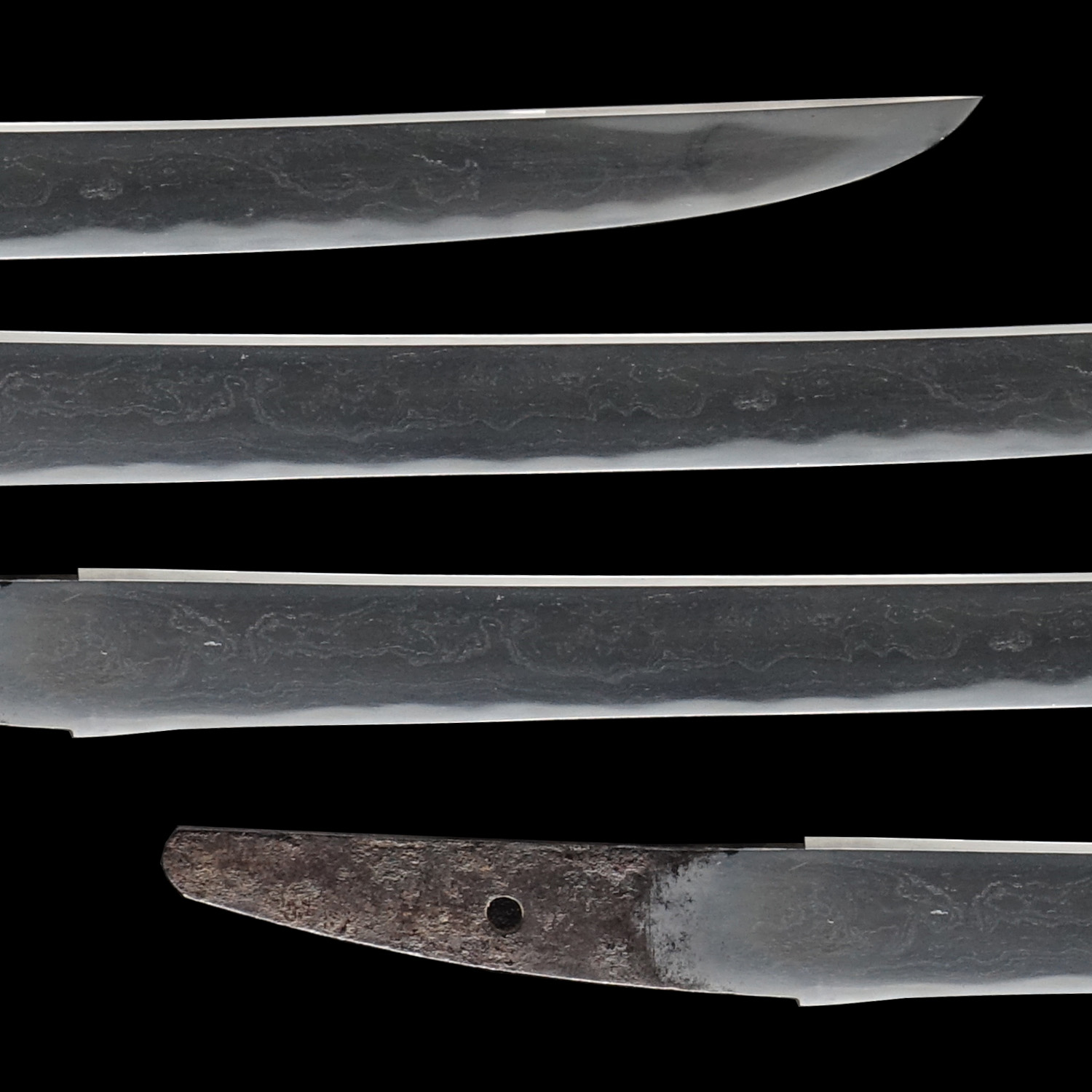



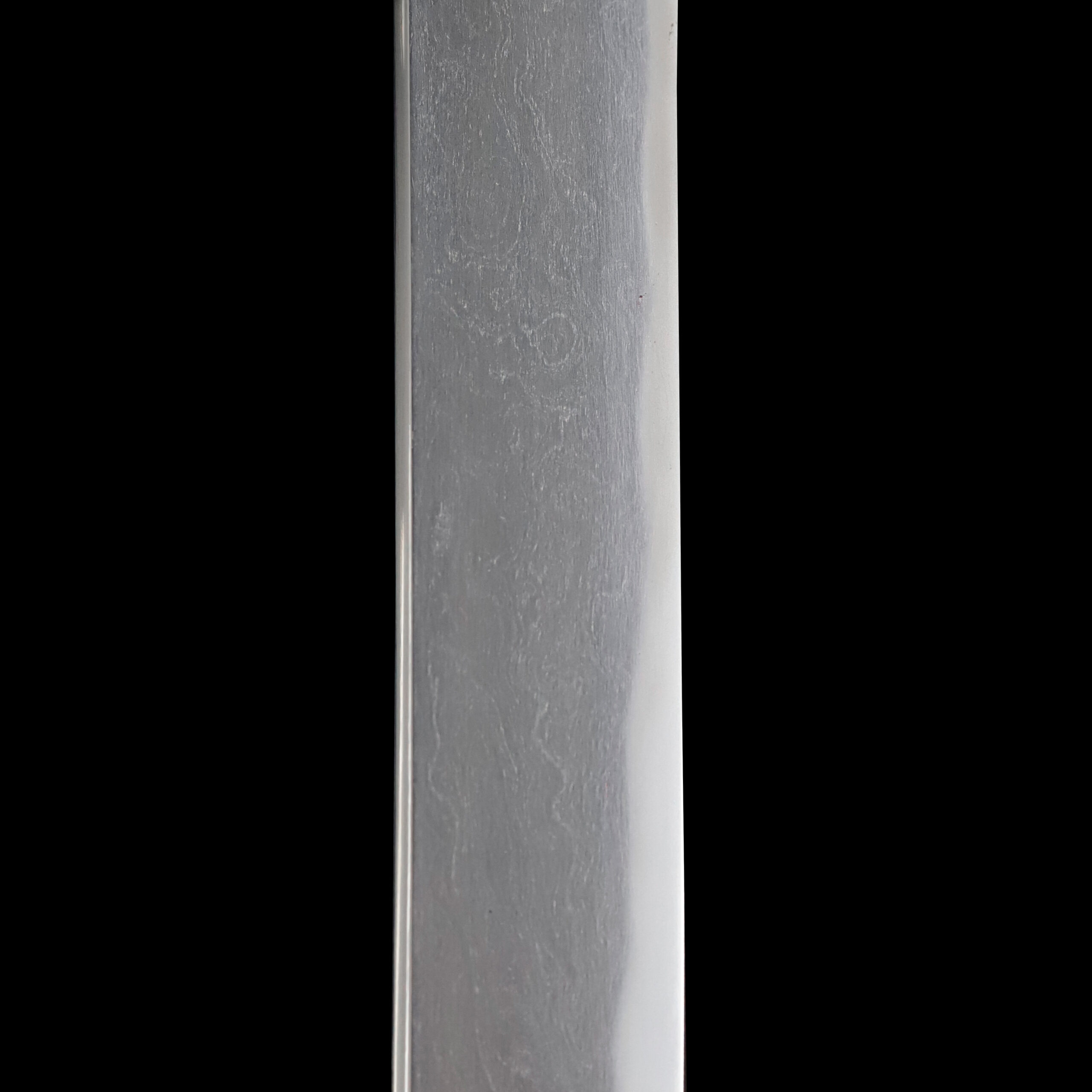
Nakago:Nakago is the tang of the Japanese sword.
Japanese swordsmiths left the black rust on the tang because it prevents red rust while the tang is in its handle. And the discoloration of the tang was created over time, and it is a great indicator for a Japanese sword specialist to estimate when the sword was forged.
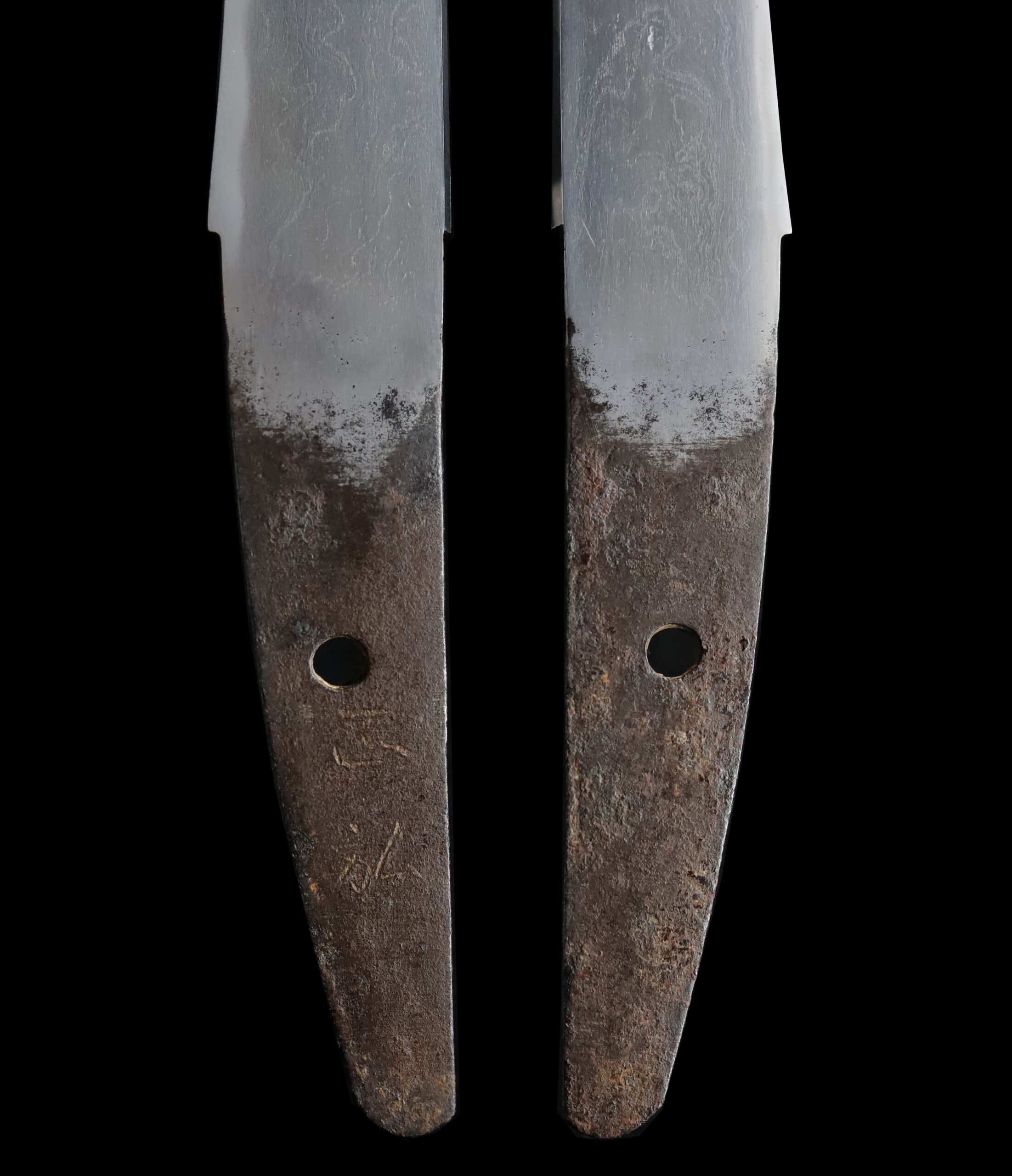
Koshirae: Koshirae is the mounting of the Japanese sword. There are several parts that consist of Koshirae such as Saya(Scabbard), Tsuka(Handle), Tsuba(Handguard).
According to NTHK, which appraised this Koshirae, it was made in the late Edo period.
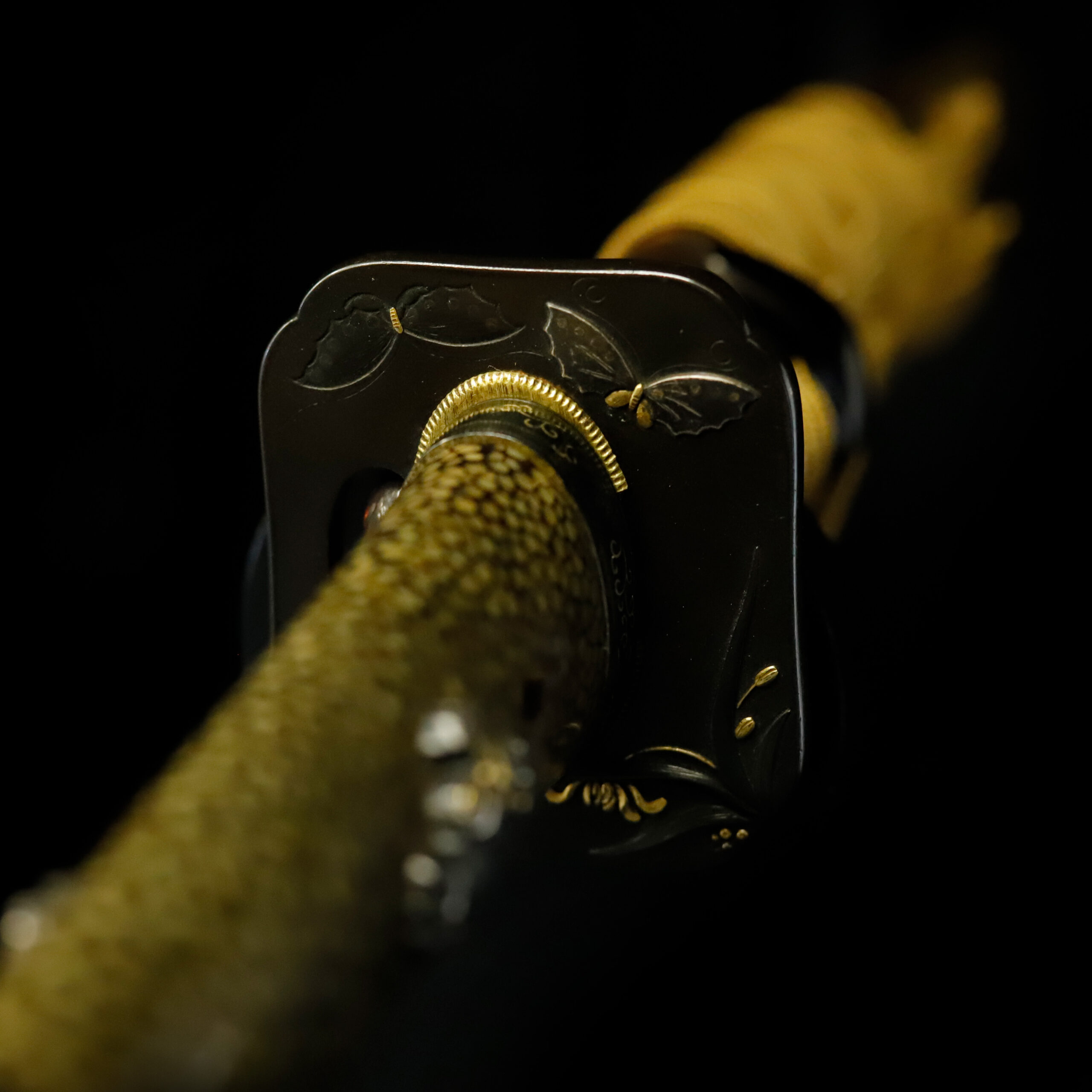
Fuchi-Kashira:A pair of matching sword fittings that cover the upper and bottom parts of its sword hilt.
This Fuchi Ksahira has different designs on each part. A kind of flower (probably chrysanthemum) patterns and Karakusa (唐草, arabesque) pattern are engraved on the Fuchi part. The Karakusa design is a pattern in which vine stems, and leaves are twined and make curves. Since ivy has a strong vitality and grows up without interruption, people regarded this design as a symbol of prosperity and longevity. On the other hand, the Kashira part depicts a landscape. Although most colorings have already faded due to aging, golden colorings that seem to be brass inlays add decorativeness to this work.
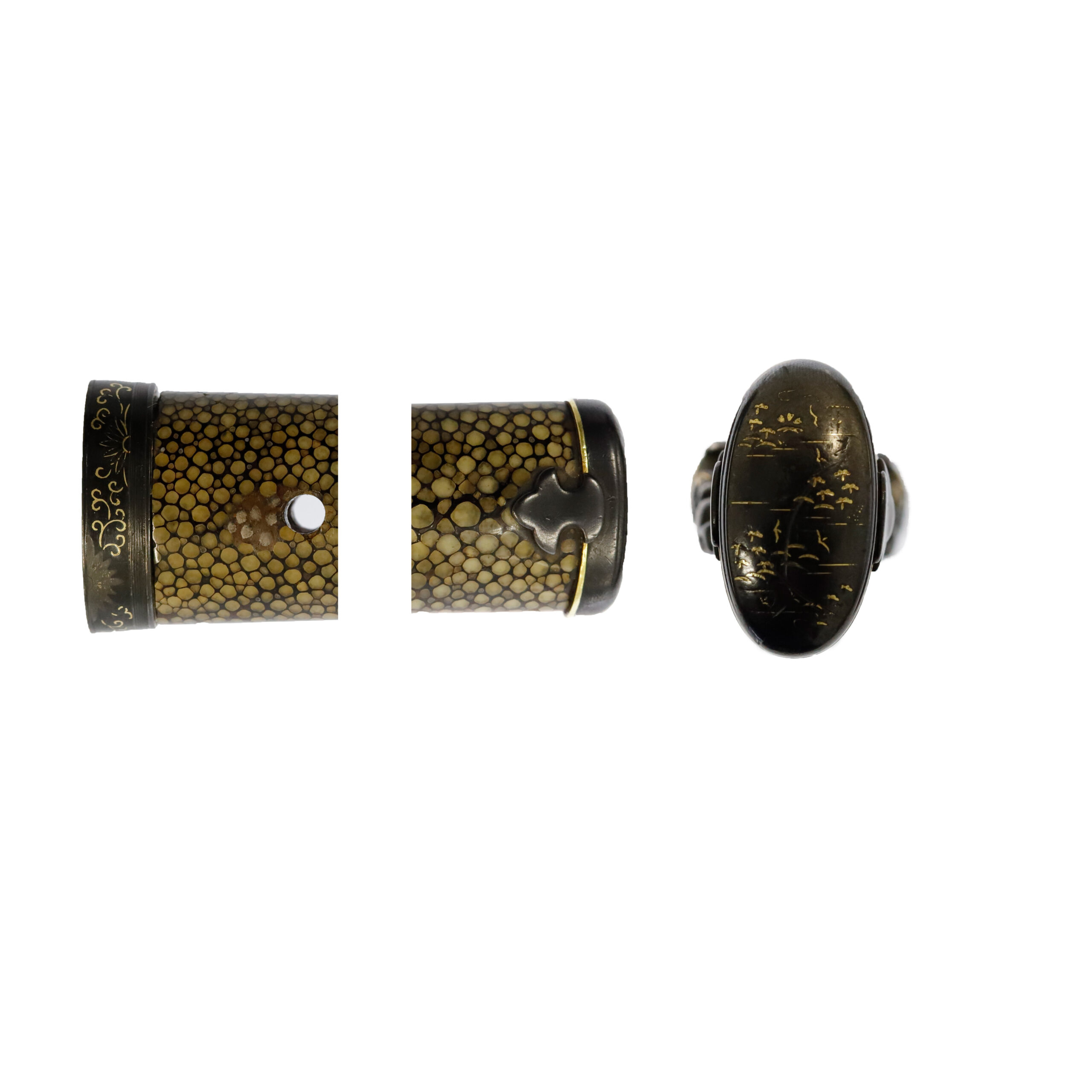
Tsuka and Menuki:Tsuka is the handle of the Japanese sword and Menuki is its decoration.
This Menuki depicts a man crossing a bridge, probably on the back of a horse or ox. It is a design that we could feel the connection with the landscape engraved on the Kashira part mentioned above.

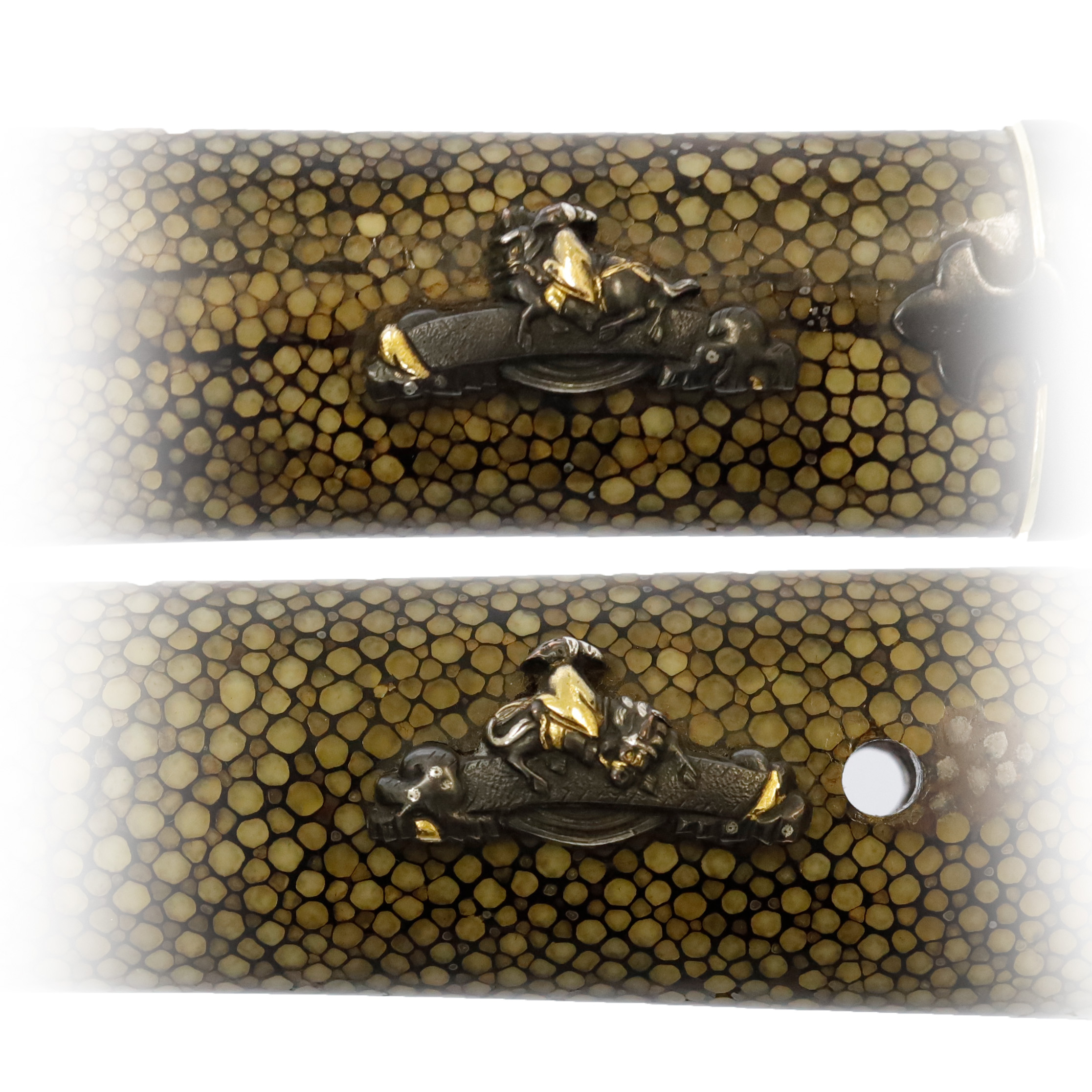
Tsuba and Habaki:Tsuba is the handguard for the Japanese Sword and Habaki is the equipment to make the blade not touch its scabbard inside. It prevents the blade from getting rusty and chipped.
You would find the figures of two Chou (蝶, butterfly) on the front of this Tsuba. People preferred the butterfly pattern due to its growth process, beauty, and auspiciousness among the various animal patterns. A larva becomes a chrysalis, and it grows up into a butterfly. Since this insect changes its looks, it symbolizes being reborn; therefore, Samurai loved this design. In this way, butterflies are seen as symbols of human life, death, and resurrection and are said to house the souls of the dead.
It is said that the butterfly pattern has been used since the Heian period (794-1185). This design was brought from the continent to Japan, and people introduced it in various fields. As proof of this, butterflies have also appeared in stories, such as the Heike-Monogatari (平家物語, The Tale of the Heike). This insect design gradually began to be used as a family crest, and it spread nationwide by being used by the Taira (平) clan. Taira-no Kiyomori (平 清盛, 1118-1181), who was the leader of the Taira family, used the Agehachou (揚羽蝶, swallowtail) crest. That is, it was treated as a symbolic design of the Heike (平家). According to a theory, about 300 Samurai used this motif for their family crests in the Edo period. It tells us the deep relationship between butterfly patterns and Samurai culture.
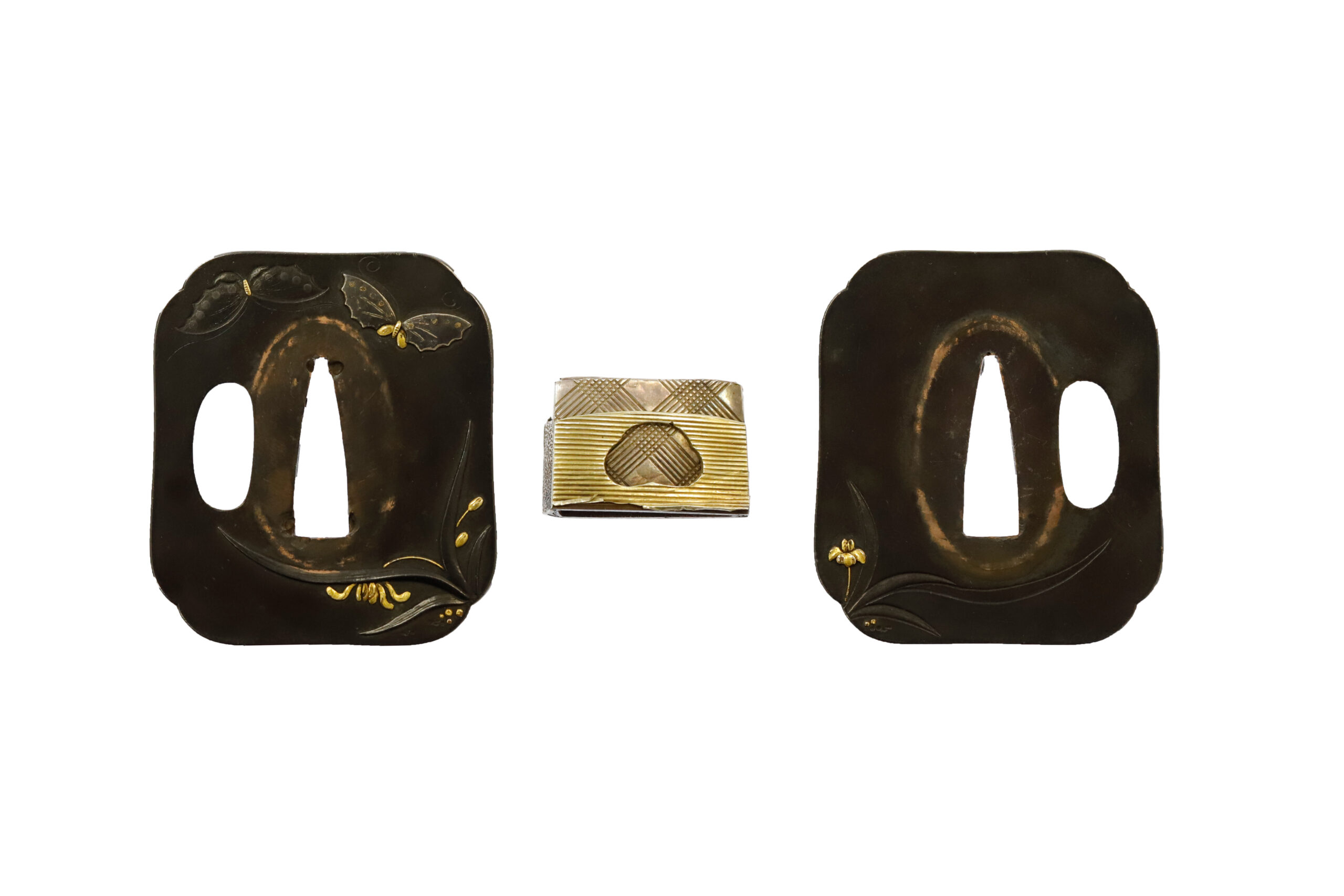
Kozuka:Kozuka is a small knife stored in Kozuka Hitsu(groove of the sheath of the Japanese sword).
A Kogatana (小刀, small knife) is stored in the Kozuka. The surface of this Kozuka is decorated with the Nanako-Ji (魚子地) technique. This process makes a uniform minimal protrusions pattern by hitting the Nanako-Ji Tagane (魚子地鏨, a chisel for this technique) on a metal surface. This decorative technique is often seen on sword mountings. About the design, fishing tackles and a shrimp figure are engraved on it. For more information, please check the description of the scabbard.

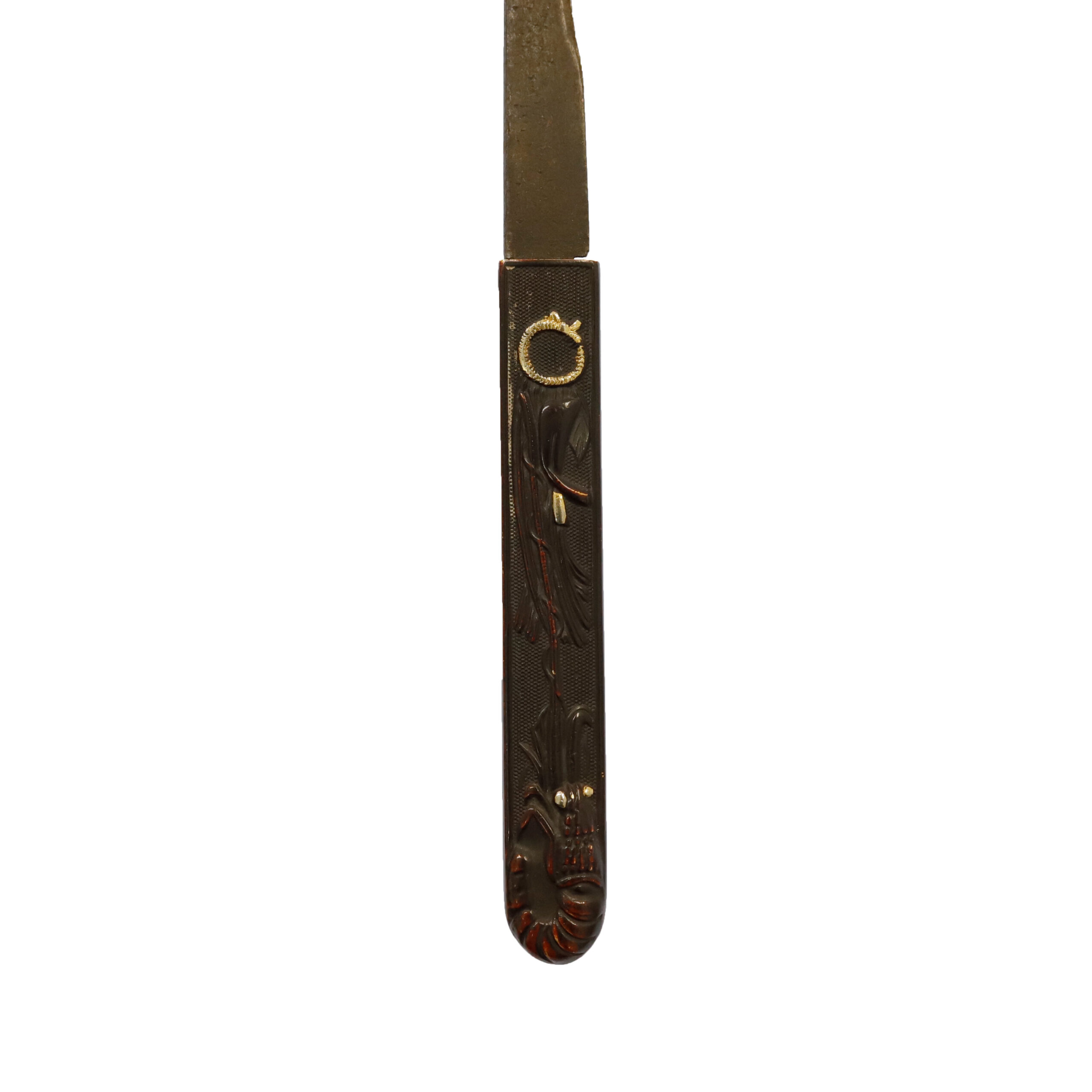
Saya: Saya is the scabbard for the Japanese sword.
*Please keep in mind that there is a very tinny crack on this Saya. If you like to see the detailed condition please feel free to contact us.
The design of Kojiri (鐺, the metal fitting that protects the tip of a scabbard) of this scabbard is an Ebi (海老, shrimp).
Judging from the physiques of shrimps designed on these sword mountings, we believe these shrimps are the Iseebis (伊勢海老, spiny lobster). According to a theory, Japanese people already ate shrimp in the Heian period (794-1185). However, it was an expensive ingredient for ordinary citizens, so only the nobility and high-class people could enjoy it. People started using shrimp as a good-omen pattern and appreciated designing it for their family crests in the Muromachi period (1336-1573).
In the Samurai’s society, as shrimp is covered with a hard shell, it was thought that a shrimp represents the figure of a brave Samurai who wears armor. It has the meaning that wishes the fate of a Samurai will last for a long time. Shrimp has been likened to an older adult because of its long feelers. Also, shrimps actively jump even though they are bowed. That is the reason why the shrimp pattern is treated as a symbol of perpetual youth and longevity. This animal shed its molt several times to grow up; therefore, some people have considered it is a symbol of success in life.
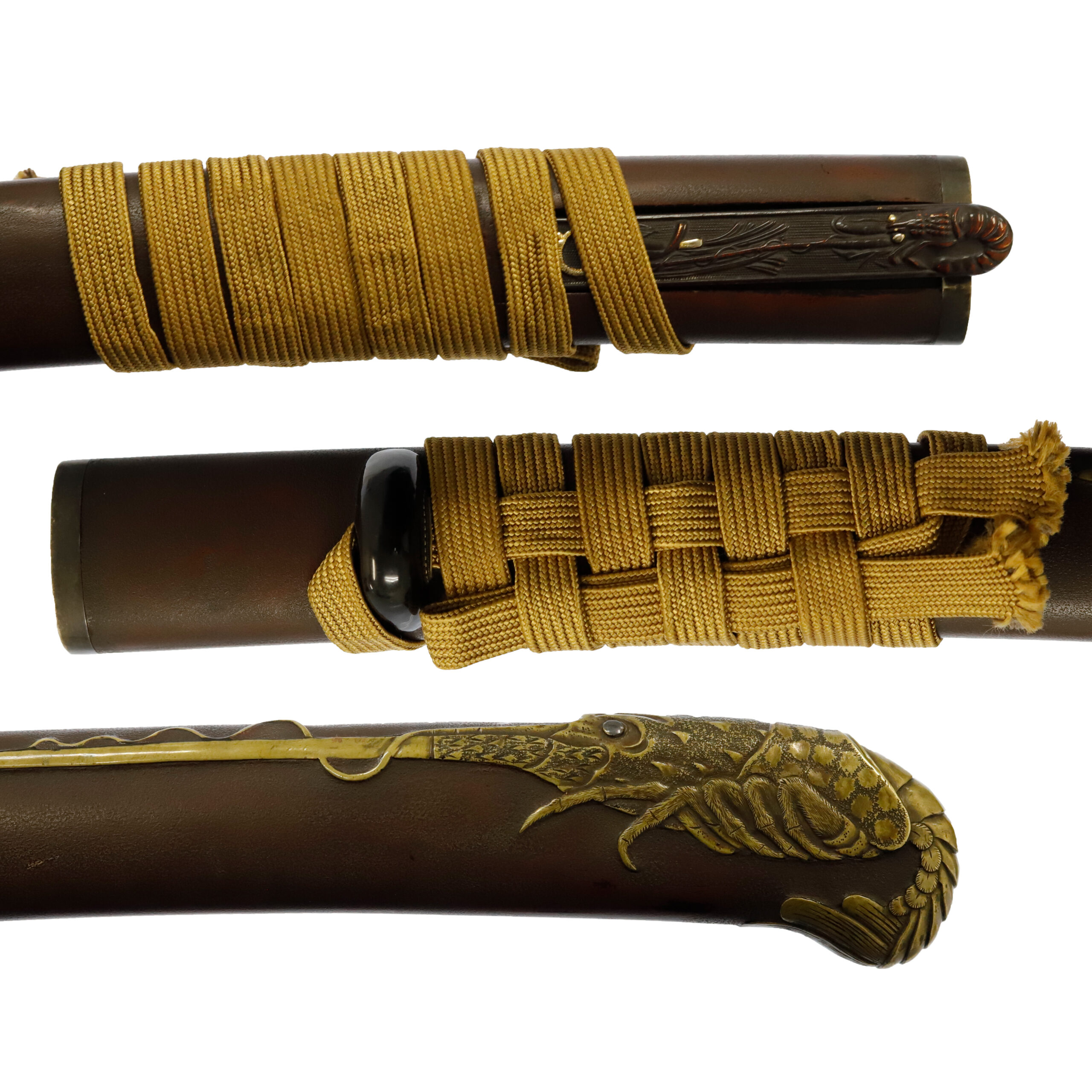


Authentication Paper:NTHK Kanteisho Certificate for the blade and Koshirae
NTHK, also known as NPO Nihon Touken Hozon Kai, is the oldest organization for sword authentication of Japanese swords in modern times. It was established in 1889 during the post-Samurai era. They authenticated the blade and sword mounting on June 18th in the 5th year of Reiwa (2023). The purchaser will receive this original certificate as well. We can also translate what is written into English and make a PDF file for your record if you request.
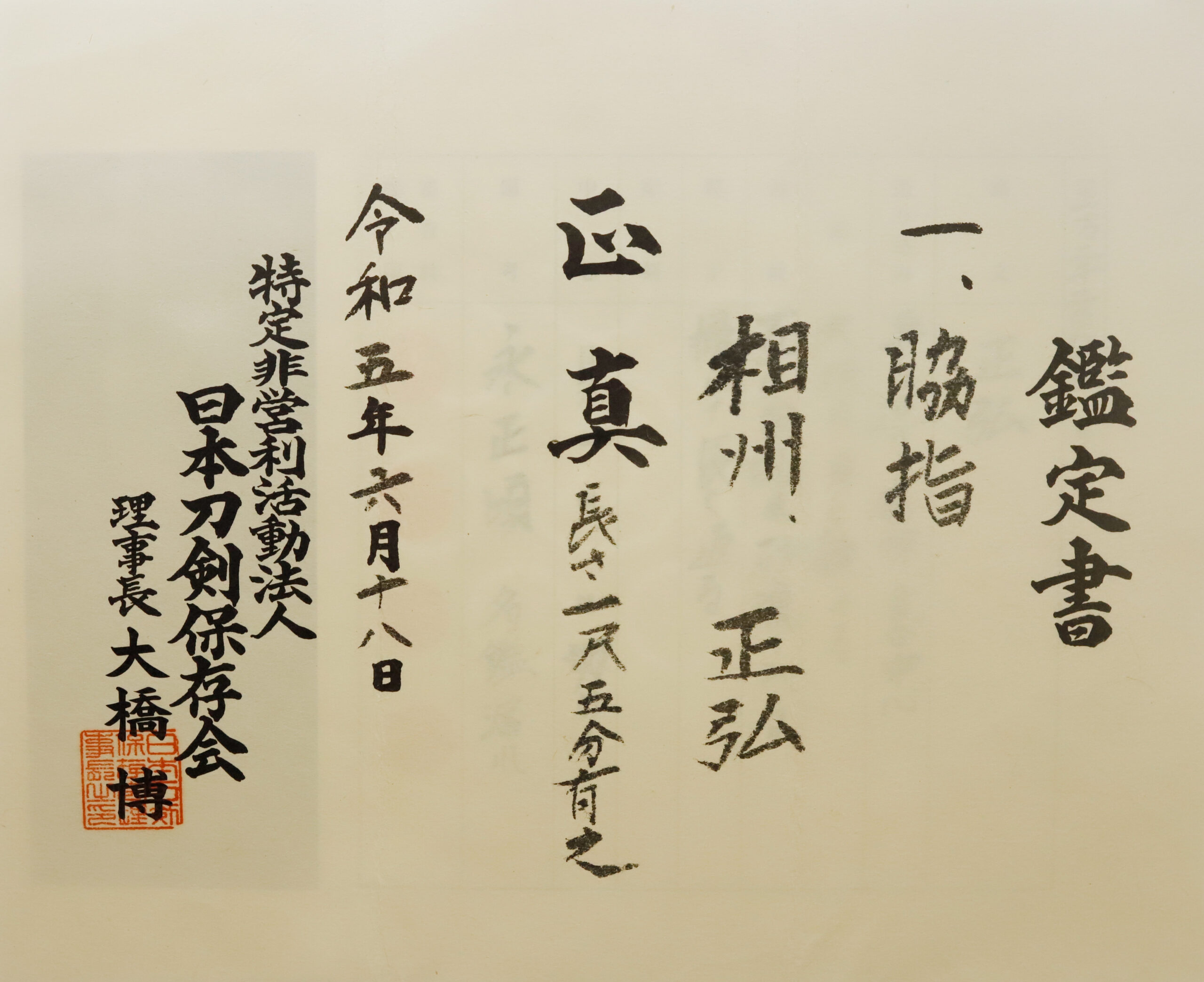

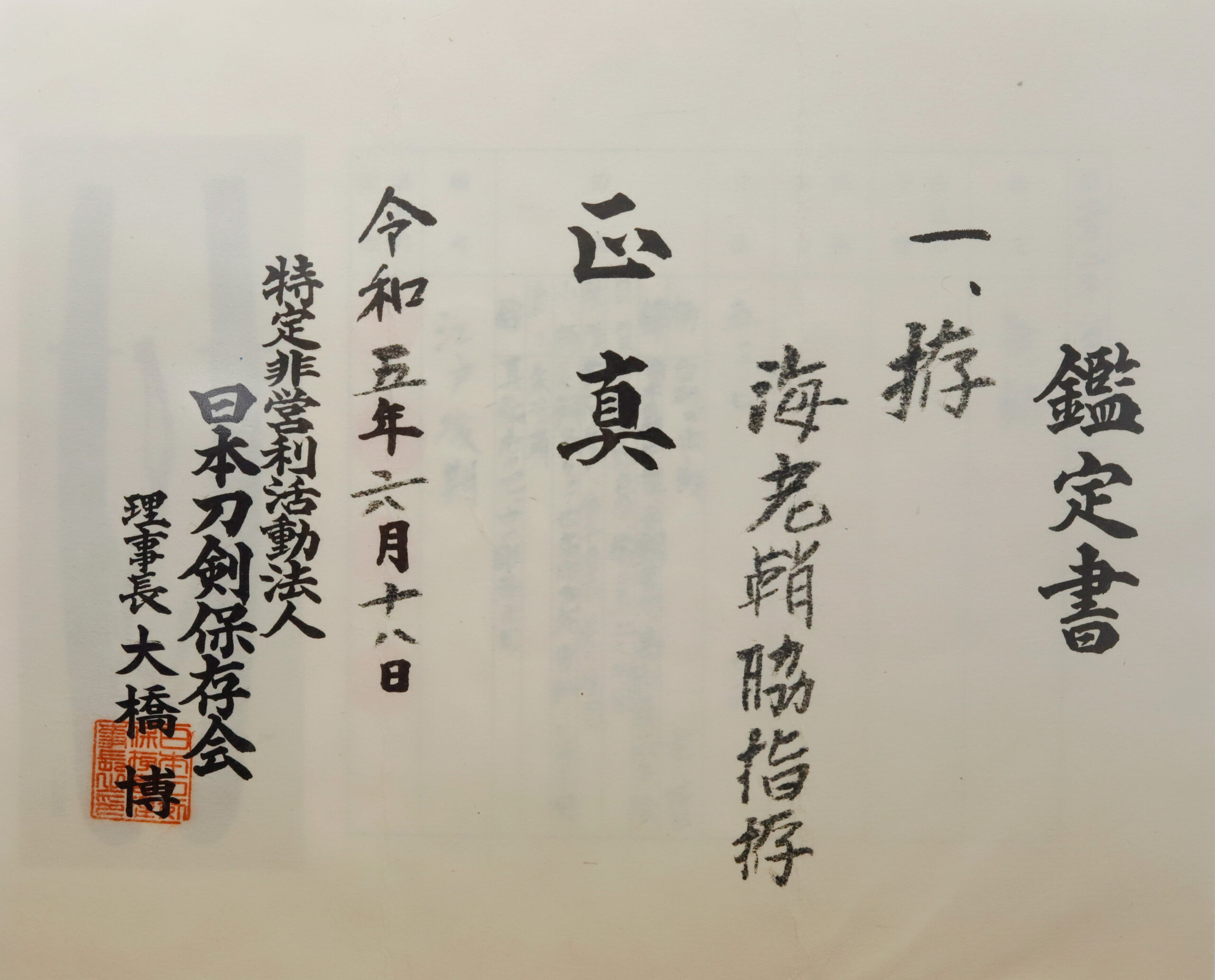

Registration Number : Tokyo 326330
The Board of Education in Tokyo prefecture issued a registration paper for this sword . It is called Jyu Token Rui Torokusho(銃刀剣類登録証). Bunkacho(The Agency for Cultural Affairs) acknowledges a Japanese sword with this paper as a work of art.
The sword needs to be traditionally hand-forged and made of Tamahagane carbon steel to be registered in the system. With this paper, its owner in Japan can legally own an authentic Japanese sword. Based on this registration number, we will apply for its export permit.
This paper will need to be returned to the board of education when the sword is being shipped abroad, but you can receive a copy of it. An English translation of this registration paper is available on request.
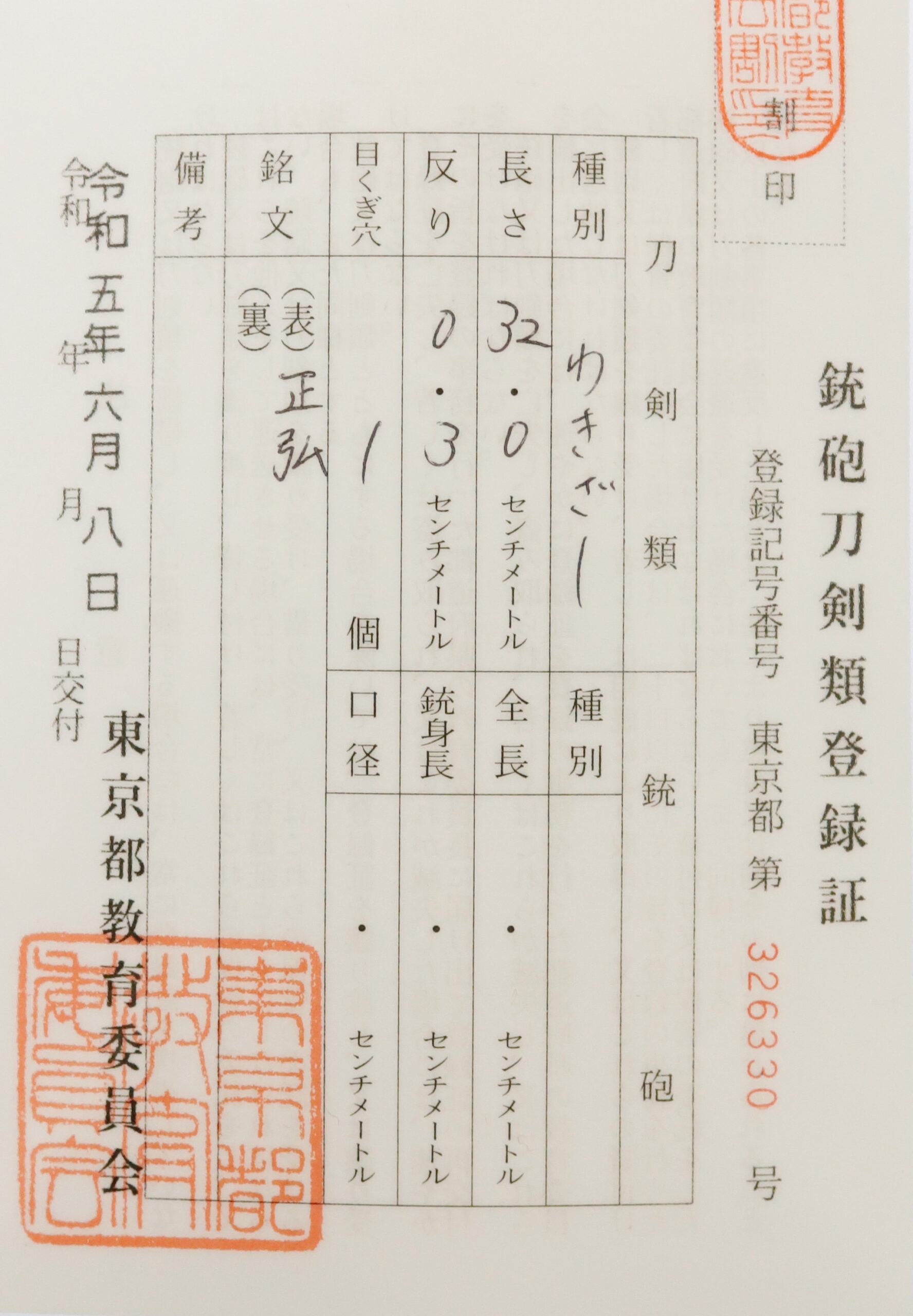

—————————————————————–
【About us】
Samurai Museum is located in Tokyo, Japan, exhibiting antique artifacts related to the Samurai history. Samurai Museum Shop is the place for those who are interested in Japanese culture and craftsmanship. We deal with antique Samurai swords/armor, traditional crafts made in Japan and so on.
【Japanese Sword& Export Process】
The Japanese swords we deal with are hand-forged edged swords made in Japan. It was made from the traditional carbon steel called TAMAHAGANE(玉鋼). Samurai Museum is familiar with the proper legal procedure for an antique/ authentic Japanese sword to be exported from Japan. We have sent more than 500 Japanese swords for the past three years (~2023) to amazing owners who appreciate its historical value.
Each Japanese sword is registered under the Agency for Cultural Affairs and the Board of Education in Japan. They issue a registration paper for each Japanese sword for its owner in Japan to legally possess it. The Japanese sword with its registration paper means it was traditionally hand-forged in Japan.
To legally export the sword from Japan to other countries, we will have to apply for its permit to the Agency for Cultural Affairs(Bunkacho) and return the original registration paper to the Board of Education. It normally takes around 2-4 weeks to receive this permit after submitting required documents. And we would like you to expect at least 1-1.5 months for your order to arrive at your given address after you ordered. For more detailed info, please click here.
It is allowed for residents in Japan to own authentic Japanese swords without a special license as long as they come with registration papers. Please feel free to contact us if you are a resident of Japan, whether temporarily or permanently. We will also assist you when you leave Japan and need to obtain the export permit.
【Payment Method】
We accept payment through Stripe (Credit card), PayPal, Apple Pay or ChromePay, all of which are secure payment methods. Also, you don’t need to make an account on Stripe for the checkout. If you prefer other payment method, please contact us. After confirming your payment, we will apply for an export permit. You may either pay in JPY, USD, AUD, CAD,EUR CHF or GBP. The price is set in Japanese Yen. Prices in other currencies are automatically calculated based on the latest exchange rate.

* If the amount is above 1 million JPY, Stripe or wire transfer will be the only options for payment.
【Shipping】
We have shipped authentic Japanese swords to the USA, UK, Canada, Mexico, Germany, Switzerland, France, Hong Kong and Australia. If you don’t live in these countries and like to order, please contact us first before making a purchase. We offer Free International Shipping as long as we can send antique Japanese swords by EMS.
We normally ship by EMS(Express Mail Service) provided by Japan Post. We will send you a tracking number for your order as soon as we hand it to the post office. We will put 100 % insurance on the shipping document without any extra charge. Based on the total amount, there might be a duty tax or other fee for you to pay, depending on the countries. We use package cushioning to protect the item and put it in a PVC pipe, which is one of the most secure packages because of its durability.
It will normally takes 5-14 days for the item to arrive at your given address after we dispatch it. Time of delivery is estimated as accurately as possible by the carrier but does not take into account any delays beyond our control such as by inclement weather, post office holiday seasons.
* If you live in Australia and like to purchase an authentic Japanese sword, please click here to know the detail.
*Please keep in mind that due to the spread of COVID-19, there might be delays in shipping. If you like to know the detail about shipping, please feel free to ask us.

【Review】
Here is one of the reviews we received from a customer who purchased an authentic Japanese sword from us. For more reviews, please click here.
“My experience overall with the whole process was wonderful. I had many questions about the history and process to purchase these treasures. All my questions were answered very timely and complete. The staff is very knowledgeable and very well versed if any questions do arise.”
【How to make sure the condition】
Please keep in mind that what you are going to purchase is an antique item. We uploaded high resolution photos for you to check its condition thoroughly. If you like to see more photos with different angles, please feel free to contact us. We will be happy to send them to you so that you can make informed decision. It is essential for us to know that you are happy with your choice of a sword. and we are prepared to use the best of our ability to serve you.
【How To Contact Us】
Please contact us through email, Facebook Messenger or Live Chat if you have any questions. You can find each icon on the right side of the website. Please click one of them to reach us. We will reply to you within 1-2 business days.
【The Art of Nihonto (Japanese Sword)】
Samurai’s history is a profound, eloquent legacy of ancient Japanese warriors in which millions of people worldwide are being fascinated. If you like to find out the art of Nihonto, please click here.
【A Guide to Japanese Sword Maintenance】
After acquiring an genuine Japanese sword, it is also important to know how to take good care of it. Here is the special video for you. Mr. Paul Martin, Japanese sword expert, shows you how to give proper maintenance to your sword. By mastering how to clean the Japanese sword, its aesthetic beauty will last forever.
When you purchase a Japanese sword from us, you can get a Free Japanese sword maintenance kit. It comes with four tools(Choji Oil, Uchiko Whetstone Powder, Peg remover, Oil Applicator). By watching the video instruction above , you can enjoy learning how to maintain your Japanese sword while appreciating it. If you have any difficulty assembling the sword or cleaning the blade, you can feel free to contact us.


MORE ANTIQUE JAPANESE SWORD FOR SALE
SWORDS WITHOUT CERTIFICATES FOR SALE
LEARN JAPANESE SWORD TERMINOLOGY
Thank you for reading all the information on the page. If you have any difficulty choosing the right Japanese sword for you, we will be more than happy to help you find the one that speaks to you the most. Please feel free to contact us.





